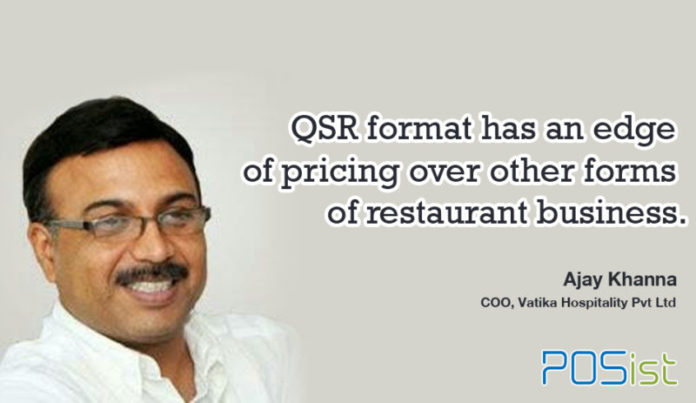With more than two decades of experience in hospitality industry, Ajay Khanna has worked with different hospitality brands under different roles. Ajay played a key role in developing, expanding and managing new outlets at Nirula’s and Reliance Industries. In his career, apart from working for hospitality brands, he has also worked with country’s largest staffing solution providing company, Teamlease to provide training to the young guns and readying them for their future endeavours in hospitality and restaurant industry. In his previous role as Chief Operating Officer, Vatika QSR Hospitality Pvt Ltd, Ajay was responsible for developing and marketing a whole new QSR brand called Nukkadwala from the scratch.
In an interview with The Restaurant Times by Posist, Ajay shares his insights on the QSR sector, how it has grown over the years and what are the prime factors of its growth.
Posist: How do you see QSR format growing in the coming years? What is the USP of this format as compared to the other forms of restaurant business?
Ajay Khanna: QSR format business is the fastest growing hospitality segment in India. In the last four to five years this format has grown by 22-25 percent CAGR (compounded annual growth rate). Out of the total, there are 3000-4000 outlets only in the Quick Service Restaurant category.
The evolution of this format was started with Nirula’s and Domino’s in 2000. Then we saw a rise of cafe formats like Barista and Cafe Coffee Day.
The prime reasons for the growth of Quick Service Restaurant are the rise of the foreign brands in the country which turned the segment into a more organized format, and the franchise model that helped to fuel the expansion.
Another reason behind the QSR growth is the low ticket size or transactional value, which is around Rs 50 -150. People don’t hesitate in spending Rs 100 in today’s time. India is typically a price sensitive market and this gives an edge to the QSR format over other forms.
Also, in QSR format the food you serve is more dependent upon the equipment, rather than the skills of the chef, as is the case with casual and fine dining restaurants. The food has to be cooked in a specific manner, which can be done by a semi-skilled chef also. In QSR format equipment takes care of skilled manpower part. The training is low in QSR format and standardization is easy compared to other formats.
Posist: How do you see restaurant policies fuelling the growth of the Restaurant industry?
Ajay Khanna: The industry is getting better and better with time. It is getting smarter, and generating a huge amount of employment. The restaurant industry is trickling down to tier-2 and tier 3 cities where QSR format is growing because of the low price point. The growth rate will get better in the coming years as a lot of equipment is now getting manufactured in India, so the price barrier is coming down for starting up. Earlier all the equipment manufacturing companies were operating through agents in India but now they have their offices due to ease of doing business and relaxation in import policy which has further helped is getting the equipment faster than previous as the lead time has reduced to 2-3 weeks from 3-4 months earlier.
Posist: You have worked in the industry for so long and especially in QSR format. What kind of advice would you like to give for selecting the right equipment for the restaurant?
Ajay Khanna: The first thing that any food entrepreneur should do is to fix the menu he wants to sell. Once the menu is fixed, the equipment is decided under any format. Also, it depends on how you want to do it. For example, you can fry a Samosa in a Kadahi, and the same thing can be done in normal fryer or chip controlled fryer also. Things like how many Samosas you want to fry drive the decisions for purchasing equipment.
To explain further, equipment depends upon the volume, size of the outlet and menu. If you are starting on your own, a lot of fabricated equipment can also be bought old or used. It is wiser to invest in cheaper equipment first and then change the decision as you move along.
Posist: Tell us about your brand Nukkadwalla. What are your expansion plans?
Ajay Khanna: Nukkadwalla is the first QSR on India cuisine. We have done a lot of research for sourcing street recipes from their origins. The research took about two and half years. Our target is the mass market as majority of our items cost between Rs 40 – Rs 80. We would have 10 outlets by November in Delhi NCR, then we will move to other parts and International. We are expecting average revenue of Rs 10-15 lakh per outlet.
As told to The Restaurant Times by Posist


















